- Gene modulation
- RNA interference
- Short hairpin RNA (shRNA)
- SMARTvector Lentiviral shRNA
SMARTvector Lentiviral shRNA
Make smart, informed choices for successful gene silencing in your cells of interest

SMARTvector Lentiviral shRNA
1Start Here
2Choose
Maximum flexibility for vector-based RNAi experiments
Because efficient gene silencing depends on both the design and level of expression of the shRNA, it is critical to choose silencing reagents where both the targeting sequence and the specific promoter driving expression are taken into consideration.
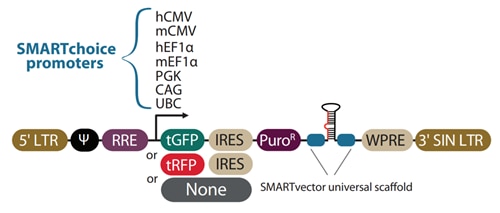
SMARTvector Lentiviral shRNAs are designed using our most advanced microRNA-based shRNA-specific rational design algorithm resulting in highly potent and specific targeting sequences. Choose from seven promoters* (human and mouse CMV, human and mouse EF1 alpha, CAG, PGK, and UBC), two fluorescent reporters (TurboGFP and TurboRFP) and a no-fluorescent reporter option to tailor SMARTvector lentiviral shRNAs for your specific cells of interest and your experimental requirements. Up to ten shRNA silencing constructs are predesigned for every gene in human, mouse and rat providing broad coverage across the entire genome.
Unsure which format you need? Learn about our SMARTchoice configuration platform *Please note that some promoter options may only be available as custom products or upon request.
Highlights
- Target any gene in human, mouse and rat, and tailor experiments to specific cells with multiple promoter options
- Guaranteed silencing (see Guarantee tab)
- Designed using microRNA scaffold-specific attributes for highly efficient processing via the endogenous RNAi pathway
- Available as glycerol stock and as purified, concentrated lentiviral particles
- Standard titers of 1 x 108 TU/mL, ± 20%, and ultra-high titers of 2 x 109 TU/mL, ± 20%; functional titers determined by flow cytometric analysis of GFP-positive, transduced HEK293T cells
- Suitable for dividing and non-dividing cell types, including difficult-to-transfect cells such as primary, neuronal and stem cells
Together, these attributes greatly enhance the functionality and specificity of lentiviral-mediated RNAi and reduce the toxicity associated with low titer preparations (supernatant).
Superior Dharmacon design algorithm
- Utilization of a highly processed, patented microRNA scaffold
- Rationally-designed, highly functional gene targeting sequences
- Algorithm trained on more than 500 endogenous mRNA data points for functional knockdown testing
- Incorporation of bioinformatics strategies to reduce off-target gene knockdown events
- Protein coding genes are targeted in the ORF and 3’UTR; lncRNAs are targeted throughout the entire transcript length
Lentiviral particle formats
At Dharmacon, we are committed to delivering high quality lentiviral particle preparations. As such, we clone, package and concentrate each construct with strict QC controls. Due to the inherent complexity of lentiviral particle production and the quality control procedures, turnaround time is estimated to be 4 to 6 weeks. We offer the following formats:
Set of 3 different gene-targeting constructs
- Ideal for evaluating multiple shRNAs targeting the same gene and ensuring mRNA knockdown in your specific cells
- 100 µL (4 x 25 µL) or 200 µL (8 x 25 µL) total amounts at 1 x 108 TU/mL, ± 20%, functional titers determined by flow cytometric analysis of GFP-positive, transduced HEK293T cells
Individual gene-targeting constructs
- Ideal for ordering one or two constructs that you have identified as being the best performers
- 100 µL (4 x 25 µL) or 200 µL (8 x 25 µL) total amounts at 1 x 108 TU/mL, ± 20%, or 100 µL (4 x 25 µL) total amount at 2 x 109 TU/mL, ± 20%, functional titers determined by flow cytometric analysis of GFP-positive, transduced HEK293T cells
SMARTvector Lentiviral Positive and Negative Controls for shRNA and microRNA experiments
- Ideal for optimizing transduction and assay conditions prior to gene-specific experimentation
- Negative control particles allow for distinguishing sequence-specific silencing from non-specific effects
- Positive control particles allow for confirmation of gene silencing using confirmed shRNA constructs targeting a housekeeping gene
- 50 µL (2 x 25 µL) at 1 x 108 TU/mL, ± 20% or 100 µL (4 x 25 µL) at 2 x 109 TU/mL, ± 20%, functional titers determined by flow cytometric analysis of GFP-positive, transduced HEK293T cells
- Learn about SMARTvector controls.
SMARTvector Lentiviral shRNA functional guarantee
When you purchase a minimum of three SMARTvector lentiviral shRNAs to the same protein-coding gene target using the optimal SMARTchoice promoter for your cell type, at least one of the shRNA constructs will reduce target mRNA levels by 70% or more when used with the vector matched non-targeting control and GAPD or PPIB positive control. Optimal promoters should be determined with the SMARTchoice promoter selection plate. mRNA levels should be measured with RT-qPCR or similar quantitative mRNA analysis no earlier than 72 hours post-transduction. The guarantee only applies to catalog numbers V3S*xxxx and does not apply to any SMARTvector shRNAs targeting lncRNA transcripts.
shRNA Controls
SMARTvector Lentiviral shRNA Controls
- Positive and negative shRNA controls with choice of four promoters and two fluorescent reporters.
- Available for human, mouse and rat.
SMARTvector Lentiviral shRNA vector elements
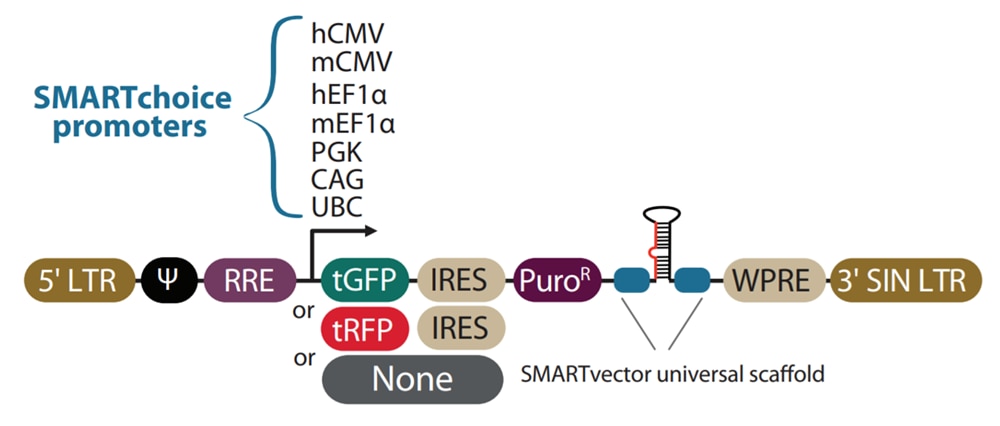
| Vector Element | Utility |
|---|---|
| 5' LTR | 5' Long Terminal Repeat necessary for lentiviral particle production and integration of the construct into the host cell genome |
| Ψ | Psi packaging sequence allows viral genome packaging using lentiviral packaging systems |
| PRRE | Rev Response Element enhances titer by increasing packaging efficiency of full-length viral genomes |
| tGFP or tRFP | TurboGFP or TurboRFP reporter for visual tracking of expression |
| None | No-reporter option for use in applications where fluorescence is not required or desired |
| IRES | Internal Ribosomal Entry Site allows expression of fluorescent marker and puromycin resistance in a single transcript |
| PuroR | Puromycin resistance permits antibioticselective pressure and propagation of stable integrants |
| SMARTvector universal scaffold | Optimized proprietary scaffold in which mature microRNA sequence is embedded |
| WPRE | Woodchuck Hepatitis Post-transcriptional Regulatory Element enhances transgene expression in target cells |
| 3' SIN LTR | 3' Self-inactivating Long Terminal Repeat for increased Lentiviral safety |
Functionality of endogenous microRNAs are different
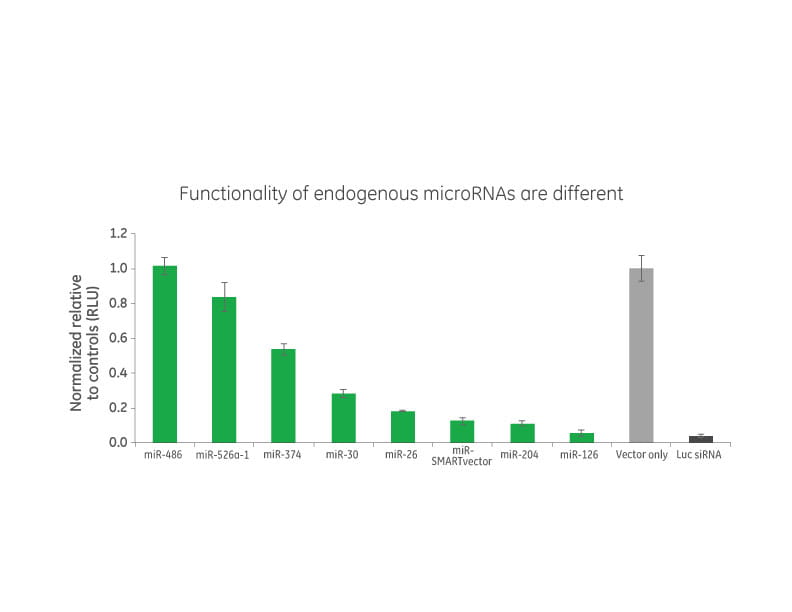
Incorporation of highly functional and appropriately processed microRNA scaffolds into lentiviral silencing constructs greatly enhances the functionality of DNA-based RNAi silencing. Different endogenous human microRNAs were tested in HeLa cells for the ability to silence their respective targets. Each microRNA exhibits a distinctive level of functionality. Several of the constructs (e.g., miR-486 and -526a) exhibited poor levels of activity, silencing their respective reporter constructs less than 20% while native miR-30 and -374 scaffolds provide moderate levels of gene silencing (~50-70%, see above). The scaffold selected as the basis for SMARTvector Lentiviral shRNAs efficiently processed and silenced its’ respective target by 80 to 90%. This highly functional microRNA represents a significant improvement over currently available microRNA-based scaffolds used in RNAi expression platforms.
Functionality of mature and passenger strands of endogenous microRNAs are different
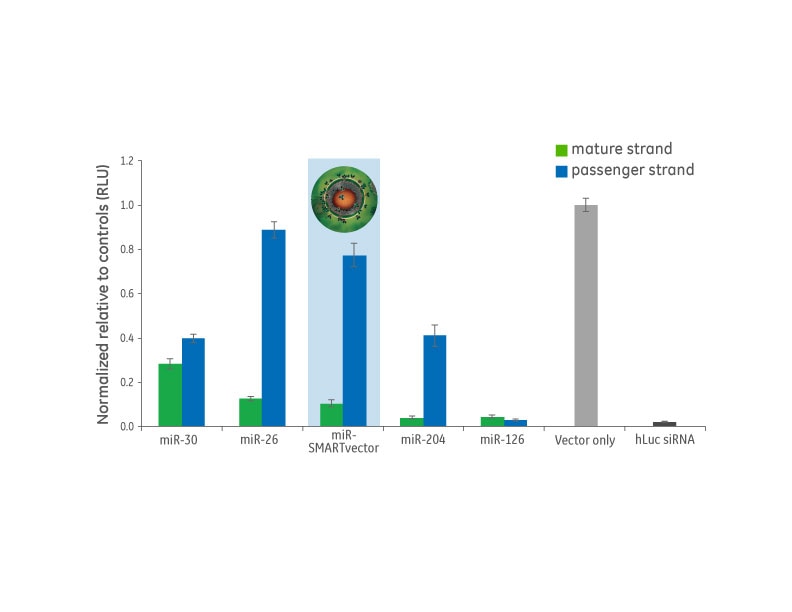
Preferred microRNA scaffolds have minimal passenger strand off-target effects. The Dharmacon team investigated the passenger strand activity of several of the scaffolds tested in the primary screen. The moderately functional miR-30 and the highly functional miR-126 exhibit undesirable passenger strand activity. In contrast, miR-SMARTvector shows potent mature strand activity with minimal passenger strand function.
microRNA-adapted shRNAs compared to simple hairpin shRNAs
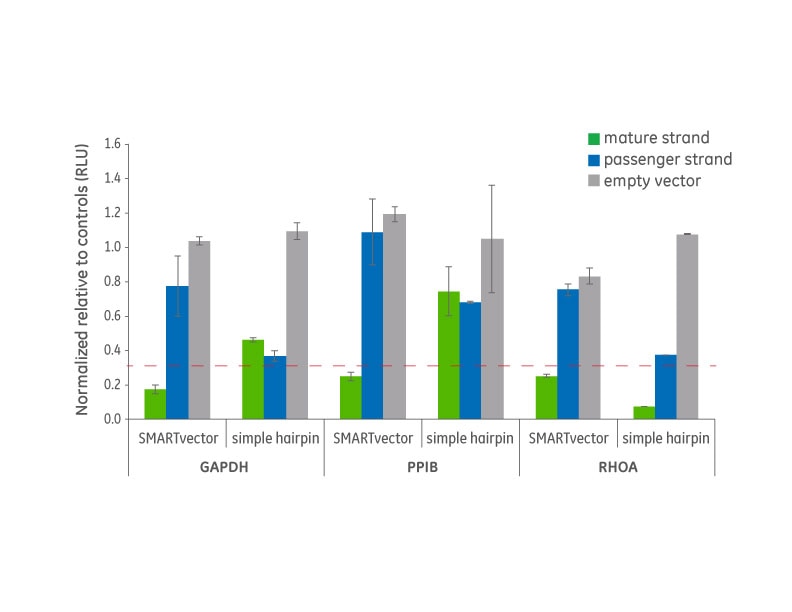
The SMARTvector microRNA-adapted shRNA platform shows considerably higher mature strand activity and lower passenger stand activity than simple hairpin shRNAs targeting the same gene. The result of the optimized microRNA-adapted scaffold is higher, more specific function while reducing the risk of off-target effects from the passenger strand.
SMARTvector lentiviral shRNA particles in two cell lines
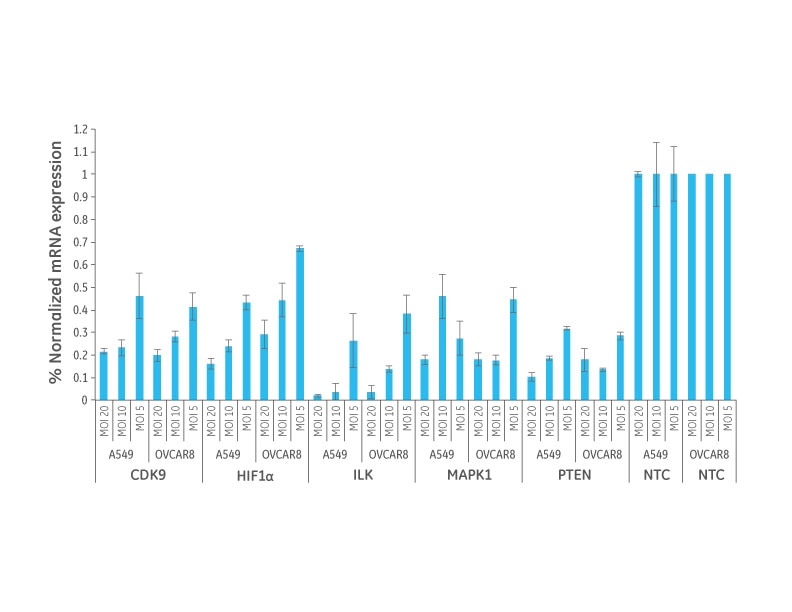
Two different cell lines were transduced with Dharmacon SMARTvector Lentiviral shRNA Particles targeting CDK9, HIF1α, ILK, MAPK1 or PTEN (as indicated) at three MOIs. mRNA knockdown was assessed 72 hours post-transduction using QuantiGene branched DNA assay (Panomics, Inc.) and normalized to SMARTvector Non-targeting Control. In most cases, 70% or greater gene knockdown was achieved in the absence of puromycin selection. Rational design, broad tropism, and GFP reporter expression facilitate transduction optimization that leads to efficient gene knockdown in cells refractory to lipid-mediated delivery.
The SMARTvector no reporter option provides equivalent gene knockdown compared to the SMARTvector constructs with a fluorescent reporter
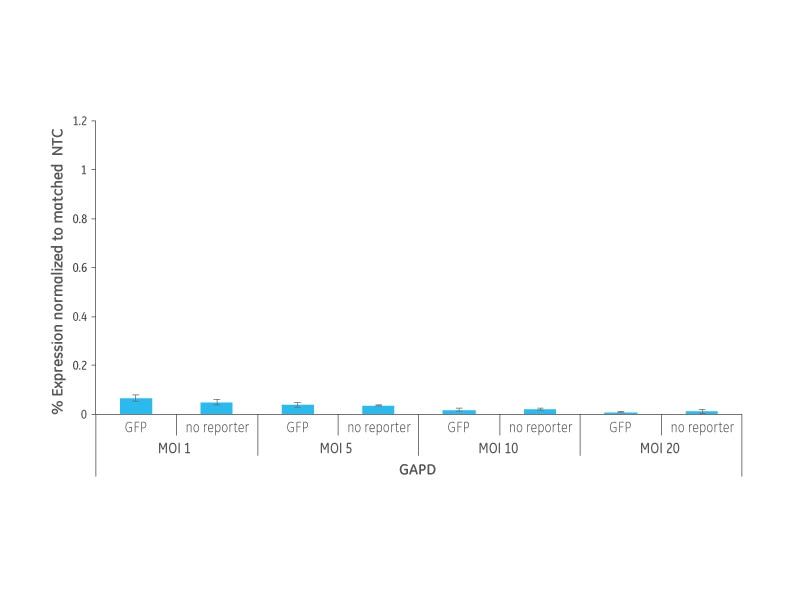
A549 cell lines were transduced with Dharmacon SMARTvector Lentiviral shRNA Particles targeting GAPD with and without a fluorescent reporter at a range of MOIs. mRNA knockdown was assessed 5 days after puromycin selection using QuantiGene branched DNA assay (Panomics, Inc.) and normalized to the matched SMARTvector Non-targeting Control. In all cases, GAPD knockdown is the similar with and without fluorescent reporter.
LentiBOOST Lentivirus Transduction Enhancer is a uniquely formulated transduction reagent that can be used with or without lentivirus spinfection in order to increase successful viral transduction events while preserving cell viability. Especially critical for preserving precious primary cells from patient cohorts, or, for engineering complex animal models; improving transduction efficiency can save time and costs by increasing the success of each editing/transduction step, or, even avoid the loss of irreplaceable samples. Additionally, LentiBOOST technology is already used in the manufacturing of a number of clinical stage therapies providing the opportunity to demonstrate improved workflow applicability to the clinic.
LentiBOOST can be purchased through the Dharmacon Reagents catalog.
To learn more about LentiBOOST technology visit the Revvity LentiBOOST webpage.
Supporting Data
Improved CD8+ T-cell SMARTvector™ shRNA lentiviral system transduction using LentiBOOST™ Lentivirus Transduction Enhancer
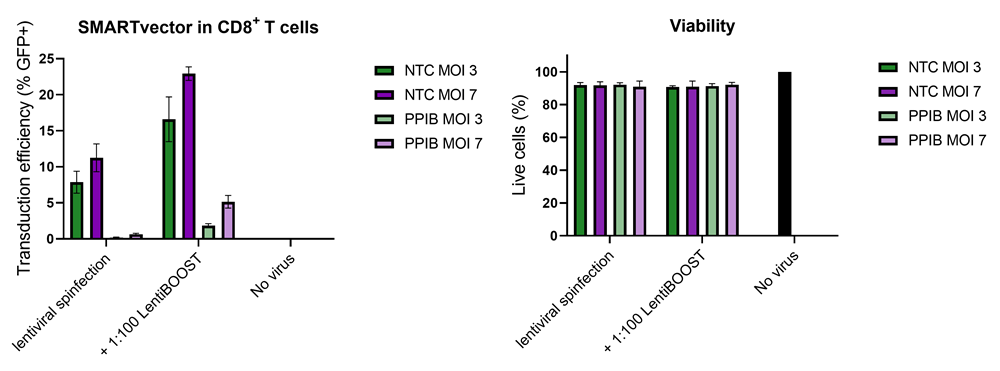
100,000 primary human CD8+ T cells were transduced with either 30,000 (MOI 3, green) or 70,000 (MOI 7, purple) TUs of SMARTVector™ mCMV tGFP Lentiviral Control Particles targeting either NTC or PPIB along with 1:100 LentiBOOST transduction enhancer. Cells were centrifuged at 800 x g for one hour at 32 °C followed by a four hour incubation prior to removal of lentiviral particles and transduction enhancer. Transduction efficiency (%GFP+ out of live cells) and viability were determined 5 days post-transduction by flow cytometry. The addition of LentiBOOST technology markedly improved transduction efficiencies without significantly impacting cell viability.
Improved CD4+ and CD8+ T-cell Edit-R™ All-in-one sgRNA/Cas9 lentiviral system transduction using LentiBOOST™ Lentivirus Transduction Enhancer
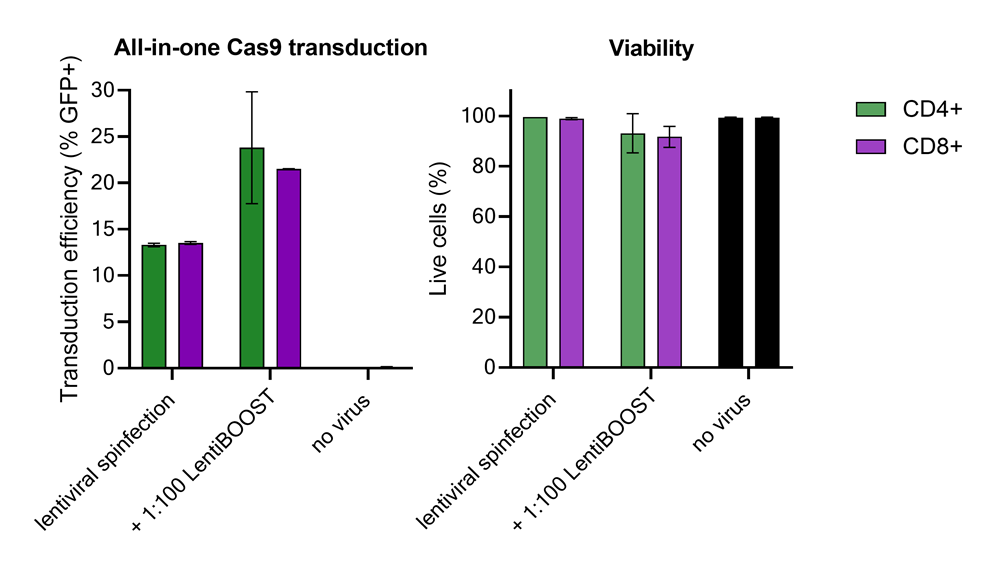
100,000 primary human CD4+ and CD8+ T cells from two donors were transduced with 250,000 TUs of Edit-R GFP Delivery controls mCMV along with 1:100 LentiBOOST transduction enhancer. Cells were centrifuged at 800 x g for one hour at 32 °C followed by an overnight incubation prior to removal of lentiviral particles and transduction enhancer. Transduction efficiency and viability were determined 72 hours post-transduction by flow cytometry. The addition of LentiBOOST technology markedly improved transduction efficiencies without significantly impacting cell viability.
Improved transduction of human induced pluripotent stem cells (hiPSCs) with the Strict-R™ Inducible CRISPRa lentiviral system transduction using LentiBOOST™ Lentivirus Transduction Enhancer

10,000 WTC hiPS cells were transduced with either 20,000 (MOI 2, green) or 40,000 (MOI 4, purple) TUs of Strict-R™ Inducible EGFP dCas9-VPR Lentiviral Particles along with 1:100 LentiBOOST transduction enhancer. Cells were centrifuged at 800 x g for one hour at 32 °C followed by an overnight incubation prior to removal of lentiviral particles and transduction enhancer. Transduction efficiency and viability were determined 72 hours post-transduction by flow cytometry. The addition of LentiBOOST markedly improved transduction efficiencies without significantly impacting cell viability.
Application notes
-
Development of the Dharmacon SMARTvector Lentiviral shRNA microRNA-adapted scaffold and algorithm for functional shRNAs - Application Note
-
SMARTvector Lentiviral shRNA - Application Note
-
SMARTvector shRNA Lentiviral Platform: Elucidating the Role of Factors Important in Neurite Outgrowth - Application Note
Protocols
Safety data sheets
Selection guides
Technical manuals
Related Products
The SMARTvector RNAi controls are cost-effective tools for determining optimal conditions for delivery prior to using gene-specific SMARTvector Lentiviral shRNAs and shMIMIC Lentiviral microRNAs.
LentiBOOST transduction enhancer can increase successful viral transduction in challenging to transduce cells, or, complex cellular engineering work; while preserving cell viability and minimizing the amount of viral particles required for your experiment. LentiBOOST technology is actively used in the production of clinical stage lentivirally delivered therapies, including some approved therapies, providing a direct path to therapeutic applicability for your research studies. Tested with Dharmacon Lentiviral reagents.
microRNAs, endogenous non-coding ~22mer RNAs, are highly conserved in mammals and regulate gene expression post-transcriptionally through innate RNA interference mechanisms. Now, stable cell lines expressing microRNAs of interest can be created using novel vectors with your choice of promoter and reporter.
shMIMIC Inducible Lentiviral microRNAs combine all the advantages of the unique shMIMIC microRNA expression design with the Tet-On 3G tetracycline-inducible expression system and the flexibility of SMARTchoice promoter and reporter options.
